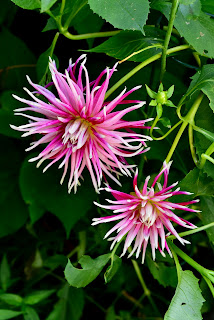 | ||
| 'True Sincerity' lived through the zero temps and is happy in its mesh bag |
I went back to look at my posting from the beginning of April when I'd noticed several of my beloved roses were turning brown. At the time, I chalked it up to the wicked week of below zero temperatures we’d experienced around Christmas.
 |
| 'South Africa', one of my new roses |
I soon discovered it wasn’t the weather at all, but wretched voles.
So, I did a little research that suggested placing chicken wire across the bottom of the hole along with a layer of pea gravel should keep varmints out. Then I ordered eight new roses and hired a gentleman to help me plant them.
 |
| 'Brociliande' returned from the dead |
As I wrote on April 8 in Bouncing back from winter woes and unfair foes: “Everything looks terrific as of this writing. I feel very confident I have done everything humanly possible to keep my new roses safe and healthy.”
Wrong.
My new ‘Flamenco Rosita’ did not last 3 days. It keeled over and the roots were gone.
 | ||||
| I reordered 'Flamenco' and she is thriving |
Time for a new plan. I dug up all the roses I had just paid to have planted and ordered 5-gallon stainless steel wire baskets. I replanted the roses in the baskets leaving an inch or two of mesh above the soil line. I also put down mole and vole repellent granules several times.
 |
| Another newbie 'Snowbelt' and catmint |
That was the beginning of April and the calendar tells me it is now October. So, what happened to the rest of spring and summer? I really haven’t a clue except this has been happening since I turned a “certain age”. Once again summer has evaporated, and Halloween is lurking just around the corner.
 |
| Butterflies loved the Pugsters |
The days may have zipped by, but I can report the roses are doing well in their baskets. I still have lots of buds and blooms. The black and blue salvias have been spectacular along with the Pugster Blue buddleias. The granules appeared to keep the woodchuck from devouring Chris little veggie patch. And the hydrangeas are finally blooming after dying back almost to the ground.
 |
| 'Indian Summer proved to be a perfect companion for 'South Africa' |
Even though summer went by with head-spinning speed, I'm grateful I took some photos to mark the progress of the garden. I hope you’ll enjoy looking back with me.
 |
| Spider Woman Dahlia and 'Sir John Betjeman |

Because despite what the calendar says, I am not ready for mums, pumpkins and black cats.
 |
| Goodbye Summer :( |
P.S. I'm also planting my alliums in small mesh bags in hopes of having at least one survive next spring.
P.P.S It didn't work. Not one allium came up.









































-
Follow Us on Twitter!
-
"Join Us on Facebook!
-
RSS
Contact